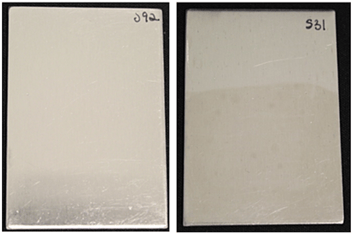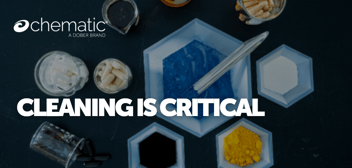Avoid The Top Five Industrial Cleaning Mistakes
Every company within the highly regulated pharmaceutical industry operates with a validated cleaning method or methods. The same typically applies to manufacturers of cosmeceuticals and personal care products — such as cosmetics, sunscreens, and lotions — as well as to biopharma, nutraceuticals, and even oral solid dose makers.
The U.S. Food and Drug Administration carefully regulates these industries. The FDA requires cleaning validation for the simple reason that the organization has been tasked with ensuring the safety of products intended for human use/consumption. If equipment is not properly, thoroughly cleaned, contamination could affect product safety. Harm to consumers — and the potential damage this harm can do to your bottom line — is an outcome no one wants.
Companies face many hurdles when it comes to bringing their products successfully to market. Among these are challenges related to cleaning. Here are some of the most common mistakes — and how you can avoid them.
1. FAILURE TO CONSIDER CLEANING CHALLENGES NOT SPECIFICALLY ADDRESSED DURING R&D
During R&D, the challenges associated with cleanup may be overlooked due to a failure to consider eventual issues with scale-up to full production. It’s relatively easy to clean small-scale R&D equipment by hand, for example, perhaps using potentially problematic organic solvents. But will those solvents remain feasible after scale-up? What about the relatively short batch-processing times encountered during R&D? Have you allowed for the additional residue buildup that may result from far longer production run times?
Rather than limiting future production capacity, it makes better sense to consider — during the R&D phase — the looming cleaning challenges related to your process. That way, you can arrive at appropriate, safe, time-saving, profit-enhancing solutions before it’s too late to seamlessly incorporate them into your process.
By factoring in appropriate cleaning methods and solutions at the beginning of a given project, you can minimize downtime further down the line. An inefficient cleaning process will have a negative impact on ultimate profitability. It makes sense, then, to consider ways to streamline and optimize the cleaning process from the start. Some pharmaceutical industry-associated materials, such as polymers, APIs, and excipients, are notoriously challenging to clean thoroughly, for instance.
2. SELECTING THE WRONG DETERGENT FOR YOUR SPECIFIC NEEDS
As noted above, cleaning is often something of an afterthought in the grand scheme of tasks involved in bringing a new product or formulation to market. Accordingly, it’s not uncommon for personnel to use cleaning supplies and/or methods that were in place since R&D, with little consideration given to the efficiency of the method — or the appropriateness of a given detergent for its target residue.
Likewise, manual cleaning methods may be carried over from R&D, even though, at full-production scales, these processes (such as manual scrubbing) will have become prohibitively cumbersome and time-consuming. Often, if solvents were used during R&D, it becomes clear during full-scale production that these solvents are no longer feasible, due to safety and/or environmental concerns. Additionally, if non-dedicated equipment is used during product changeovers, cleaning of these items of equipment becomes crucial to avoid the risk of cross-contamination.
In a highly competitive industry such as pharma, time is of the essence. Erratic cleaning times due to inefficient cleaning methods and detergents may negatively impact your production schedule — and thus, your bottom line. Effective cleaning of industrial equipment warrants considerably more attention to the detergent(s) used.
A one-size-fits-all detergent does not apply to pharmaceutical manufacturing cleaning processes. Selecting the appropriate detergent usually requires exploratory lab studies once the need is discovered.
3. IMPLEMENTING THE WRONG CLEANING PROCESS
It should go without saying that starting with the wrong detergent ensures that your cleaning process will never achieve optimal cleaning and minimal downtimes. In fact, selecting an inappropriate detergent for the cleaning task at hand all but ensures eventual inefficiency, longer cleaning times (meaning longer production-line downtimes), and greater difficulty achieving cleaning validation.
Our extensive experience as a developer of industry-specific cleaning solutions has yielded some notable examples of real-world problems related to this key mistake. Common sense suggests, for instance, that hotter water is better when it comes to cleaning. But common sense is not always right. Some APIs and excipients, for example, are actually more readily cleaned using room-temperature water. Since it doesn’t require energy to heat, the latter is less expensive to use, of course. And in this example, cool water actually did a better job.
Some companies use a single cleaning product and then attempt to adapt that product for future, additional tasks. Pharma experts need to recognize that every process, product, and phase of production may involve wildly different cleaning challenges.
4. IGNORING THE EFFECTS OF EXCIPIENTS
Another common mistake is focusing on, for example, a given API, while ignoring excipients also incorporated into the production stream. Make this mistake, and cleaning validation could ultimately fail. It’s understandable that engineers would focus on all-important active ingredients while neglecting to consider otherwise inert fillers. But experience has shown that excipients can pose thorny cleaning challenges of their own.
Again, it pays to investigate the appropriate, specific cleaning agents for a given job, long before ramping up to full-production capacity. Chematic critical cleaning detergents are designed to tackle even the most formidable cleaning challenges. We specialize in aqueous-based detergents for a wide range of cleaning goals.
Wondering if you are using the appropriate detergents/processes for your specific needs? Try Chematic’s two week custom cleaning evaluation to see if you are cleaning with the right process.
5. ALLOWING UNEXPECTED HURDLES TO ARISE DURING SCALE-UP
Evaluating potential detergents and cleaning procedures on a small scale is a common practice. It makes sense to investigate this aspect of production well before ramping up to full-scale production, or even pilot-scale production. After all, validating the residual analysis method can be a time-consuming task. Unfortunately, cleaning at small or pilot scale does not always replicate conditions that will be encountered during full production runs. Some of these conditions may render small-scale processes inadequate. And that could prevent you from achieving cleaning validation.
To avoid this pitfall, list all the variables that might affect your cleaning process. Then use this information to extrapolate problems you may encounter during cleaning at full-production scale. Examples of issues to consider include: the impact of any residues; issues related to cleaning capability; considerations related to proposed detergent(s); regulatory considerations.
IN CONCLUSION
As we have seen, the pharmaceutical, cosmetic, nutraceutical, and bio-pharmaceutical industries face many challenges related to bringing successful, profitable products to market. Not least of these is the need to achieve proper FDA-mandated cleaning validation. Cleaning regulations protect not only consumers but manufacturers as well. In addition to potentially harming consumers, unsafe products caused by improper equipment cleaning would be bad for business — if not for the reputations of all companies involved in a given industry.
At Dober, we believe it makes better sense to think of cleaning as an initial step in production, not a final one. That way, regardless of prior uses for R&D or pilot runs, equipment is sure to be pristine and ready for safe, sanitary, uncontaminated production. For more information about our custom-tailored Chematic® cleaning solutions, contact us, or give our knowledgeable sales team a call at 1-844-537-5519. Or fill out our online form and we’ll help you get started toward cleaning validation.


